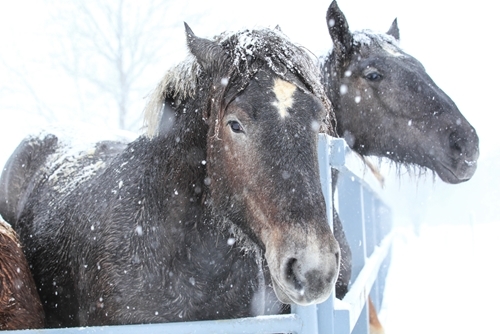The winter season can be harsh enough to make anyone shiver. But for horses, it’s usually even more difficult to stay healthy this time of year, especially if they’re frequently training outdoors. Everything from feeding methods to hoof care should be altered when horses are immersed in the cold weather, and even adding some horse supplements to their diet can help protect them from getting sick. If you and your horse are enduring a tough winter season, here are a few tips to keep your horse active and healthy amidst the cold:
Shelter temperatures
Horses are obviously strong and durable animals, and their tolerance for the cold is extraordinary when compared to humans. However, horses definitely need adequate shelter conditions to help maintain their vitality. According to equine researchers from the University of Minnesota, horses are most comfortable at temperatures between 18 and 59 degrees Fahrenheit, varying by how long or thick their coat is. A three-sided, roofed shelter is generally a quality environment for a horse to stay in during the winter, but remember that it’s important you don’t keep your horses inside the shelter throughout the day. Keep the doors to the shelter open at night so they can still get some fresh air in the evening.
Water and feeding
How you feed and provide water to your horse during the wintertime can be drastically different from other seasons. The cold temperatures typically require trainers to increase the amount of food and water horses receive, as they tend to use up more energy maintaining body warmth. The University of Minnesota reports that horses generally drink less water during the winter, which may lead to serious consequences. If you notice your horse has an overall lack of energy, thick saliva, dry skin or poor listening skills, it may be a sign of dehydration. Adding feed supplements to your horse’s winter diet can replace much-needed electrolytes and help rehydrate your horse.
As for feeding, the worst thing you can do for your horse is provide it with the same amount or less food than you normally do in warmer temperatures. A general rule of thumb is the shorter hair your horse has, the more food you’ll need to give it to make up for its winter energy conversion to supply body warmth. This is especially true with smaller horses, as staying warm is more difficult because they lack the body fat and weight that larger horses carry with them. The types of food and nutrients you’re supplying to your horse don’t have to necessarily change when the temperature drops; however, you might want to consider adding more fiber into the horse’s diet, as HorseChannel.com reports that digesting fiber will help the horse feel warmer. Adding electrolyte supplements to your horse’s feed can also help boost its immune system, which in turn will help protect it from unwanted germs and bacteria.
Staying active
Exercise should never cease just because the temperature is getting colder outside. If your horse is staying confined for longer periods of time, it may negatively impact everything from its performance levels to digestion. Horse hooves also tend to grow at a slower pace during the winter, so you’ll only need to trim them every eight to 12 weeks. As for blanketing, it’s typically a good idea to only keep your horse blanketed when it is remaining stationary outdoors or clipped. Remember: If you’re avoiding exercise for your horse just because it’s snowing or the temperature has significantly dropped, you’re only increasing its risk of injury when you begin riding it more often during nicer weather.








